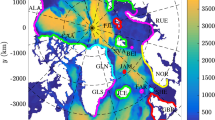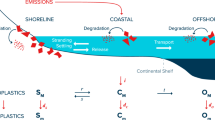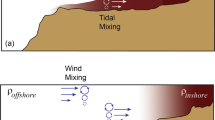Abstract
The devastating tsunami triggered by the Tōhoku-Oki earthquake of 11 March 2011 caused a crisis at the Fukushima Daiichi nuclear power station where it overtopped the seawall defences. On retreating, the tsunami carried loose debris and wreckage seaward and marshalled buoyant material into extensive plumes. Widespread concern over the fate of these and numerous other Tōhoku tsunami depositions prompted attempts to simulate debris dispersion throughout the wider Pacific. However, the effects of locally perturbed wind and wave fields, active Langmuir circulation and current-induced attrition determine a complex and poorly understood morphology for large floating agglomerations. Here we show that the early post-tsunami evolution of marine-debris plumes near Fukushima Daiichi was also shaped by near-surface wind modifications that took place above relatively calm (lower surface roughness) waters covered by surface films derived from oil and other contaminants. High-spatial-resolution satellite tracking reveals faster-than-expected floating-debris motions and invigorated plume evolution within these regions, while numerical modelling of turbulent air flow over the low-drag, film-covered surface predicts typically metre-per-second wind strengthening at centimetric heights, sufficient to explain the observed debris-speed increases. Wind restructuring probably stimulates the dispersion of flotsam from both biological and anthropogenic sources throughout a global ocean of highly variable surface roughness.
This is a preview of subscription content, access via your institution
Access options
Access Nature and 54 other Nature Portfolio journals
Get Nature+, our best-value online-access subscription
$29.99 / 30 days
cancel any time
Subscribe to this journal
Receive 12 print issues and online access
$259.00 per year
only $21.58 per issue
Buy this article
- Purchase on Springer Link
- Instant access to full article PDF
Prices may be subject to local taxes which are calculated during checkout



Similar content being viewed by others
References
Mitsuyasu, H. & Honda, T. in Wave Dynamics and Radio Probing of the Ocean Surface (eds Phillips, O. M. & Hasselmann, K.) 95–115 (Plenum, 1986).
Charnotskii, M., Ermakov, S., Ostrovsky, L. & Schomina, O. Effect of film slicks on near-surface wind. Dynam. Atmos. Oceans 75, 118–128 (2016).
Shomina, O., Ermakov, S., Kapustin, I. & Lazareva, T. Wind flow modulation due to variations of the water surface roughness. Geophys. Res. Abstr. 18, EGU2016-653 (2016).
Munk, W., Armi, L., Fischer, K. & Zachariasen, F. Spirals on the Sea. Proc. R. Soc. Lond. A 456, 1217–1280 (2000).
Wurl, O., Wurl, E., Miller, L., Johnson, K. & Vagle, S. Formation and global distribution of sea-surface microlayers. Biogeosciences 8, 121–135 (2011).
Welander, P. On the generation of wind streaks on the sea surface by the action of a surface film. Tellus 15, 67–71 (1963).
Barger, W. R., Garrett, W. D., Mollo-Christensen, E. L. & Ruggles, K. W. Effects of an artificial sea slick upon the atmosphere and ocean. J. Appl. Meteorol. 9, 396–400 (1970).
Garrett, W. D. Damping of capillary waves of the air–sea interface by oceanic surface-active material. J. Mar. Res. 25, 279–291 (1967).
Hühnerfuss, H., Alpers, W., Garrett, W. D., Lange, P. A. & Stolte, S. Attenuation of capillary and gravity waves at sea by monomolecular organic surface films. J. Geophys. Res. 88, 9809–9816 (1983).
Alpers, W. & Hühnerfuss, H. The damping of ocean waves by surface films: a new look at an old problem. J. Geophys. Res. 94, 6251–6265 (1989).
Espedal, H. A., Johannessen, O. M. & Knulst, J. Satellite detection of natural films on the ocean surface. Geophys. Res. Lett. 23, 3151–3154 (1996).
Jones, C. E., Minchew, B., Holt, B. & Hensley, S. in Monitoring and Modeling The Deepwater Horizon Oil Spill: A Record-Breaking Enterprise (eds Liu, Y., MacFadyen, A., Ji, Z.-G. & Weisberg, R. H.) 33–50 (American Geophysical Union, 2011).
Zheng, Y., Bourassa, M. A. & Hughes, P. Influences of sea surface temperature gradients and surface roughness changes on the motion of surface oil: a simple idealized study. J. Appl. Meteorol. 52, 1561–1575 (2013).
Peltzer, R. D., Griffin, O. M., Barger, W. R. & Kaiser, J. A. C. High-resolution measurement of surface-active film redistribution in ship wakes. J. Geophys. Res. 97, 5231–5252 (1992).
Ochadlick, A. R. Jr, Cho, P. & Evans-Morgis, J. Synthetic aperture radar observations of currents colocated with slicks. J. Geophys. Res. 97, 5325–5330 (1992).
Wood, D. H. Internal boundary layer growth following a step change in surface roughness. Bound.-Layer Meteorol. 22, 241–244 (1982).
Iwasaki, A., Miyatani, S. & Nakasuka, S. Satellite contributions to disaster monitoring—Japanese Earthquake and Tsunami Case in 2011. In Proc. 26th Annual AIAA/USU Conference on Small Satellites SSC12-XII-1 (2012).
Arii, M., Koiwa, M. & Aoki, Y. Applicability of SAR to marine debris surveillance after the Great East Japan Earthquake. IEEE Trans. Geosci. Remote Sens. 5, 1729–1744 (2014).
Raby, A., Macabuag, J., Pomonis, A., Wilkinson, S. & Rossetto, T. Implications of the 2011 Great East Japan Tsunami on sea defence design. Int. J. Disaster Risk Reduct. 14, 332–346 (2015).
Tohoku Tsunami Debris (NASA/GSFC/METI/ERSDAC/JAROS and U.S./Japan ASTER Science Team, 2011); http://www.jpl.nasa.gov/spaceimages/details.php?id=PIA14271
Lebreton, L. C.-M. & Borrero, J. C. Modeling the transport and accumulation floating debris generated by the 11 March 2011 Tohoku tsunami. Mar. Poll. Bull. 66, 53–58 (2011).
Miyazawa, Y. et al. Inverse estimation of source parameters of oceanic radioactivity dispersion models associated with the Fukushima accident. Biogeosciences 10, 2349–2363 (2013).
A Report on Forecasts of Tsunami Driftage Location (Government of Japan, Ministry of the Environment, 2014); https://www.env.go.jp/en/headline/2071.html
IPRC Tsunami Debris Models (eds Maximenko, N. & Hafner, J.) (International Pacific Research Center, 2012); http://iprc.soest.hawaii.edu/news/marine_and_tsunami_debris/IPRC_tsunami_debris_models.php
Thorpe, S. A. Langmuir circulation. Ann. Rev. Fluid Mech. 36, 55–79 (2004).
Chelton, D. B., Schlax, M. G., Freilich, M. H. & Milliff, R. F. Satellite measurements reveal persistent small-scale features in ocean winds. Science 303, 978–983 (2004).
Small, R. J. et al. Air–sea interaction over ocean fronts and eddies. Dyn. Atmos. Oceans 45, 274–319 (2008).
Etling, D. & Brown, R. A. Roll vortices in the planetary boundary layer: a review. Bound.-Layer Meteorol. 65, 215–218 (1993).
Vandemark, D. et al. Measured changes in ocean surface roughness due to atmospheric boundary layer rolls. J. Geophys. Res. 106, 4639–4654 (2001).
Cox, C. & Munk, W. Measurement of the roughness of the sea surface from photographs of the Sun’s glitter. J. Opt. Soc. Am. 44, 838–850 (1954).
Matthews, J. P. Stereo observation of lakes and coastal zones using ASTER imagery. Remote Sens. Environ. 99, 16–30 (2005).
Haimbach, S. P. & Wu, J. Directional slope distributions of wind-disturbed water surface. Radio Sci. 21, 73–79 (1986).
Peake, W. H. & Oliver, T. L. The Response of Terrestrial Surfaces at Microwave Frequencies Technical Report AFAL-TR-70-301 (Ohio State University Department of Electrical Engineering, 1971); www.dtic.mil/dtic/tr/fulltext/u2/884106.pdf
Acknowledgements
The authors acknowledge support from Y. Ishikawa, T. Kitano, Y. Miyazawa and S. Varlamov. J.P.M. acknowledges research support from the Japan Society for the Promotion of Science (JSPS), Kakenhi grant no. 25610140 and wishes to express gratitude to the School of Ocean Sciences and the Library and Information Services of the University of Bangor, Wales.
Author information
Authors and Affiliations
Contributions
J.P.M. conceived and led the project, analysed the satellite imagery, provided theoretical input and wrote the paper. L.O. developed theoretical models of the impact of horizontally varying surface roughness on near-surface wind velocity profiles. Y.Y. used the large eddy simulation (LES) technique to quantify debris-plume motions in the early post-tsunami phase. S.K. developed an LES-based laboratory-flow analogue of water motion around a floating debris raft to shed light on the process of lateral decay. H.T. derived realistic Stokes drift motion contributions based on an advanced third-generation wave model (WAVEWATCH III). All authors contributed to the analysis of the results and the development of the article.
Corresponding author
Ethics declarations
Competing interests
The authors declare no competing financial interests.
Supplementary information
Supplementary Information
Supplementary Information (PDF 1867 kb)
Rights and permissions
About this article
Cite this article
Matthews, J., Ostrovsky, L., Yoshikawa, Y. et al. Dynamics and early post-tsunami evolution of floating marine debris near Fukushima Daiichi. Nature Geosci 10, 598–603 (2017). https://doi.org/10.1038/ngeo2975
Received:
Accepted:
Published:
Issue Date:
DOI: https://doi.org/10.1038/ngeo2975
This article is cited by
-
Validation and error analysis of wave-modified ocean surface currents in the northwestern Pacific Ocean
Journal of Oceanology and Limnology (2022)



